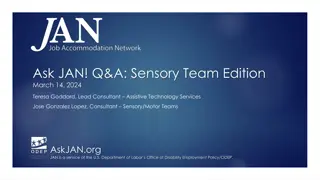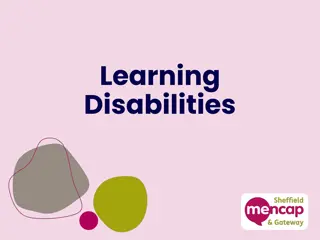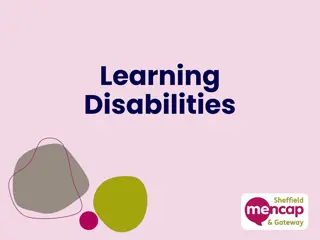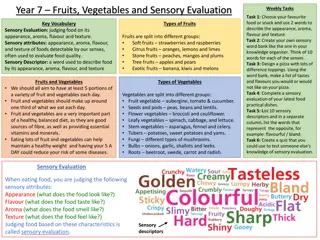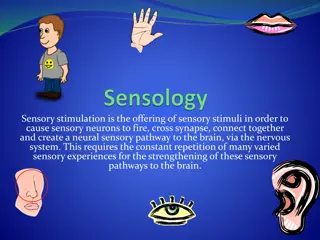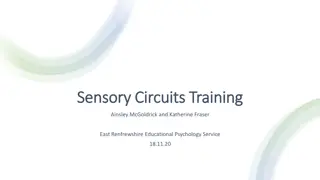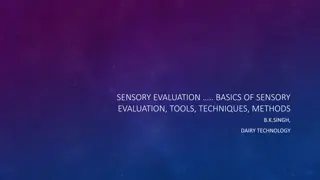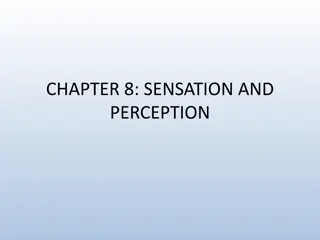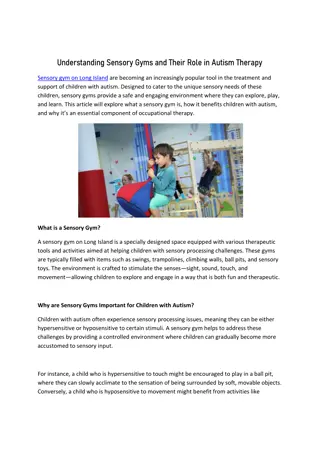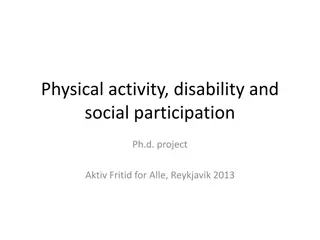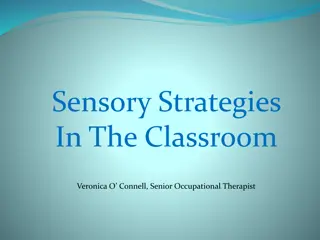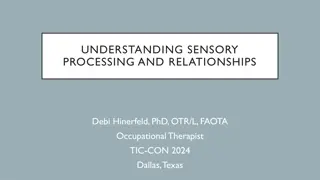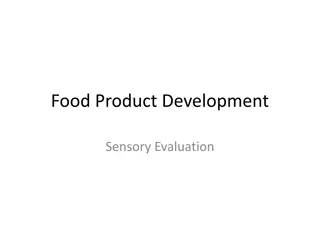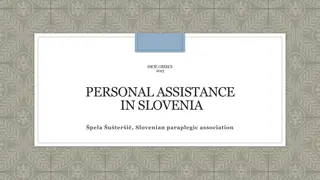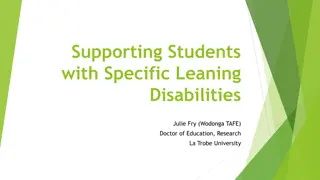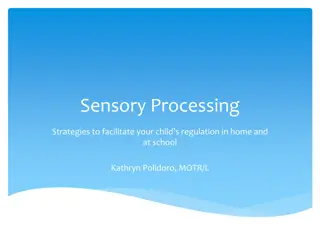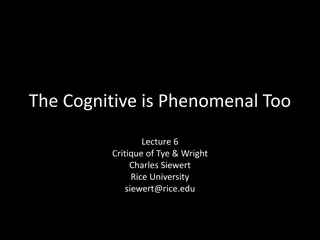Understanding Sensory Activity for People with Profound Learning Disabilities
Exploring the importance of sensory activity for individuals with profound learning disabilities, this session delves into meaningful engagement through sensory experiences. Key findings from a 2018 survey are shared, highlighting the need for resource development and sharing. The focus is on sensory engagement, developmental activities, and enriched experiences, emphasizing the significance of understanding individuals' sensory levels for meaningful interactions.
Download Presentation

Please find below an Image/Link to download the presentation.
The content on the website is provided AS IS for your information and personal use only. It may not be sold, licensed, or shared on other websites without obtaining consent from the author. Download presentation by click this link. If you encounter any issues during the download, it is possible that the publisher has removed the file from their server.
E N D
Presentation Transcript
Sensory activity and people with profound and multiple learning disabilities October 2021 RCOTSSPLD PMLD Network Study Day David Haines Principal Lecturer, University of Brighton d.Haines@brighton.ac.uk
Plan for this session Present some key findings from the 2018 RCOT SSPLD survey of Specialist Section members re their use of Sensory Activity Discuss whether: there is a need for development of resources or a way of sharing resources in this area Who might take this forward and how How this might be supported by the PMLD Network/ the NEC of RCOTSSPLD
What do we mean by sensory activity ? For people with profound and multiple learning disabilities, meaningful or authentic engagement in occupation implies: engaging in activity in non-typical ways engaging in developmentally-appropriate sensory activity , or doing regular things in a very sensory way . understanding the sensory level at which someone might be functioning and how this impacts on the level of engagement in activity they are likely to be able to achieve and what they are likely to find meaningful. Meaning to these individuals lies in the sensory aspects of activities, paying maximal attention to process rather than end result [Meaningful activities for people with profound and multiple learning disabilities] recognise that many people experience the world largely on a sensory level and take this into account Haines 2015 Mencap 2011, p.40
Survey of RCOT SSPLD members Service evaluation survey Online using onlinesurveys.ac.uk (BOS) Summer 2018 19 respondents Mean years working as an OT = 19.65 (range 1-37, SD 9.98) Mean years working in LD = 15.29 (range 1-30 years, SD8.69) Detailed responses approx. 15,000 words Qualitative data analysed using thematic analysis
Sensory-engagement, sensory-focused activities, sensory-developmental activities, sensory-enriched activities Respondents generally agreed with the definition of sensory activity see their perspective and see the world through their eyes Meaningful activity/ engagement with a sensory approach Additional/ alternative wording was suggested by some Someone is engaging at a sensory level and that should be the focus of all activity Activity as an experience for the individual
Key themes People s typical levels of engagement and support workers understandings Occupational therapy and sensory activity General principles Indicators of engagement Getting to know people well enough Building close, creative and responsive relationships The kinds of activities that work Theory that supports sensory activity Resources used/ created
Levels of engagement vary hugely/ mixed understandings Typical levels of engagement Some excellent, enthusiastic, open- minded support workers Pitching it at wrong developmental level, one size fits all & Engagement opportunities missed Support workers understandings of sensory activity Misunderstanding independence Values base Structural issues Therefore important for us to get involved
Occupational therapy use of sensory activity We do a lot of this sort of work Good outcomes: now a natural part of their thinking Can be seen as a lower priority focus on those at obvious risk
Individualise, offer new opportunities It is complex be flexible Pitch at the right level Persistence it takes time, offer more than once A small period of engagement = success Don t assume you will always get it right General principles underpinning sensory activity 1 Plan beforehand so everything is to hand, best time of day Regular opportunities positive value in smallest opportunity
Environments that maximise opportunity Cover all senses, but one type of activity at a time Encourage choice and control Share positive examples e.g. photos/videos of them engaged Careful observations before, during and after Involve others SALT, students General principles underpinning sensory activity 2 Get to know them well level of engagement and sensory preferences
What might indicate that someone is engaged? Variation in mood Vocalisations Choosing or doing something Persisting, trying again Knowing the person well Not necessarily physically doing something Movements
Getting to know people well enough to interpret subtle behaviours meaningfully Spending time with them Observing them Speaking to people who know them well Sensory preference assessment Intensive interaction Time consuming
Do you use standardised assessments ? No (but might do) 5 Pool Activity Levels 9 Sensory Profile, Sensory Integration Inventory (revised) 5 Others (1 or 2) Paediatric Pain Profile MOHO Explor AMPS Disability Distress Assessment Tool
Building close, creative and responsive relationships Really being with them Adapting communication The relationship builds through finding ways to engage them Mirroring Authentic engagement in occupation for people with PMLD comes out of a close, creative and responsive relationship between the individual and the person supporting engagement the supporter needing to remain in step . Humour Imagination Haines 2015
What kind of activities work? Personal care activities Household activities Respondents had LOADS of ideas! Sensory room activities Targeting specific senses Multi-sensory stories, book in a bag Outside the home
What theory can support use of sensory activity? Occupational science 6 Pool activity levels 16 1. Theories chosen from list Levels of intentional/ pre- intentional communication* 4 Sensory integration 13 Person-centred active support^ 12 Intensive interaction** 15 *Coupe O Kane and Goldbart (1998) ^Mansell & Beadle-Brown 2012 **Coia and Handley 2008, Nind 2009
What theory can support use of sensory activity? Vona du Toit Model of Creative Ability Partial participation 2. Other theories mentioned (free text) Developmental theories e.g. Piaget Volition Person-centred planning MOHO, AMPS
What theory can support use of sensory activity? Co-occupation (Pierce 2003; Pickens and Pizur-Barnekow 2009) 3. Theories from given list that respondents did not mention Affect attunement (Griffiths and Smith 2015)
Avoid jargon, use own words I explain the basic theory How do you use theory? Explain in report, guidelines, plans, recording sheets Clearly link to an individual Demonstrate more than explain Training package, materials I don t give them the theory they switch off
Resources used and created to support and inform sensory activity Suggestions for how to do sensory activity on a budget Sharing published resources Always have a box of stuff in the cupboard Training packages General guidance, e.g. re sensory room Individualised OT report etc
Activity guides, activity cards Report template Individualised occupational therapy report and resources Info re sensory engagement, using everyday items in a sensory way Laminated schedules and prompts Engagement and activity passports Engagement questionnaires Sensory response monitoring sheet Sensory diet plans
Some occupational therapists are using sensory activity a lot with people with learning disabilities and those that support them Conclusions Although overlapping, the findings do suggest that sensory activity is a distinctive intervention from sensory integration We are passionate about this kind of work and its potential for improving people s occupational lives! There are untapped resources related to sensory activity in our teams which could be shared Surveys can produce surprisingly excellent qualitative data if you ask the right questions of the right people
Taking it forward Where do we take the findings from this service evaluation survey, undertaken on your behalf, next? What resources might be useful for the PMLD Network/ RCOT SSPLD to consider developing? Might you be interested in becoming involved in the next stage?
Any questions? For further information contact: David Haines d.haines@brighton.ac.uk 01273 643661
Coia P, Handley AJ (2008) Developing relationships with people with profound learning disabilities through intensive interactions. In: Zeedyk MS, ed. Promoting social interaction for individuals with communicative impairments: Making contact. London, England: Jessica Kingsley Publishers. 102- 118. References Coupe O'Kane J, Goldbart J (1988) Communication before speech : normal development and impaired communication. Melbourne: Law Book Co. Griffiths C, Smith M (2015) Attuning: A communication process between people with severe and profound intellectual disability and their interaction partners. Journal of Applied Research in Intellectual Disabilities. Early view online 5.3.15 Haines D ( 2015) Occupational therapy supporting people with profound intellectual disabilities to engage in occupation at home. PhD Thesis, University of Brighton. Mahoney W, Roberts E (2009) Co-occupation in a day program for adults with developmental disabilities. Journal of Occupational Science, 16(3), 170-179.
Mansell J, Beadle-Brown J (2012) Active support: enabling and empowering people with intellectual disabilities. London: Jessica Kingsley. References Mencap (2011) Lambeth PMLD Project: understanding the lives and needs of people with profound and multiple learning disabilities in Lambeth. London: Mencap Nind M (2009) Promoting the emotional well-being of people with profound and multiple intellectual disabilities: A holistic approach through intensive interaction. In: Pawlyn J, Carnaby, S, eds. Profound intellectual and multiple disabilities: Nursing complex needs. London: Wiley-Blackwell. 62-77. Pierce DE (2003) Occupation by design: building therapeutic power. Philadelphia PA: F A Davis. Pizur-Barnekow K, Knutson J (2009) A comparison of the personality dimensions and behavior changes that occur during solitary and co-occupation. Journal of Occupational Science: Australia, 16(3), 157. Pool J (2012) The Pool Activity Level (PAL) instrument for occupational profiling: a practical resource for carers of people with cognitive impairment. 4th ed. London: Jessica Kingsley


